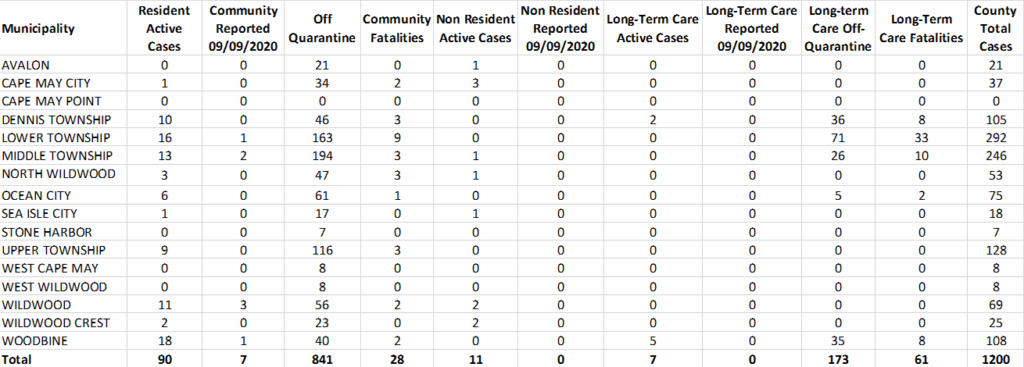COURT HOUSE – Sept. 9: The Cape May County Health Department is reporting seven new positive cases among county residents. The county is thankful to have zero new deaths to report.
According to a release, total positive cases of COVID-19 infection, in Cape May County, is now 1,200, including 89 deaths.
Gov. Phil Murphy Sept. 1 issued Executive Order No. 183, allowing indoor dining at retail food and beverage establishments. The establishments are to adhere to the protocols listed below:
Food Establishment Responsibilities for Indoor Dinning
- Ensure all areas designated for food and/or beverage consumption are in compliance with applicable local, State, and Federal regulations.
- Establish a written, worksite-specific COVID-19 prevention plan at every location, perform a comprehensive risk assessment of all work areas, and designate a person to implement the plan.
- Limit the number of patrons in indoor areas to 25 percent of the food or beverage establishment’s indoor capacity, excluding the food or beverage establishment’s employees. Ensure that the new maximum occupancy limits are posted.
- Post signage at the entrance that states that no one with a fever or symptoms of
- COVID-19 should enter the establishment.
- Ensure that tables where individuals or groups are seated are six feet (6 ft) apart in all directions from any other table or seat and that individual seats in any shared area that is not reserved for individual groups, such as an indoor bar area, are also six feet apart in all directions from any other table or seat.
- Limit seating to a maximum of eight (8) customers per table (unless they are from a family from the same household).
- Bar seating may be utilized if customers are seated and comply with physical distancing guideline of at least 6 ft between customers. Standing in a bar area is not permitted.
- A maximum of 4 customers that have a common relationship may sit together at the bar, while adhering to the physical distancing guidelines between other customers.
- Install physical barriers and partitions at cash registers, bars, host stands and other area where maintaining physical distance of 6 ft is difficult.
- Rope-off or otherwise mark tables, chairs and bar stools that are not to be used.
- Provide physical guides, such as tape on floors and signage on walls to remind customers/visitors to remain at least 6 ft apart in line and/or in common areas.
- Eliminate self-service food such as buffets and salad bars. Limit self-service drink stations to those that can be routinely and effectively cleaned and disinfected.
- Eliminate all amenities and congregate areas such as children’s recreational/play areas, dance floors, and game rooms that encourage close person to person interaction.
- Consider using digital menus, single-use disposable menus (e.g., paper) discarded after each customer, or a written posting such as a chalkboard or whiteboard to relay menu information. Businesses shall use such alternatives where traditional menus cannot be appropriately sanitized between uses.
- Consider using single-use condiments and table items.
- Require all reusable linen napkins and/or tablecloths to be laundered after each customer or party’s use.
- Provide hand sanitizers with at least 60% alcohol for employees and customers close to workstations and customer tables.
- Use touchless payment options as much as possible, if available.
- Implement a restroom use policy to limit the number of customers inside the restroom.
- Ensure that live performers remain at least 10 ft from patrons and staff.
- Consider conducting health checks for all live performers and encourage the use of masks when feasible.
Cleaning and Disinfection
- Disinfect all tables, chairs and any other shared items (menus, condiments, pens) after each use.
- Clean commonly touched surfaces in restrooms (e.g., toilet seats, doorknobs, stall handles, sinks, paper towel dispensers, soap dispensers) frequently and in accordance with CDC guidelines.
- Conduct frequent disinfecting of heavy transit areas and high-touch surfaces (e.g., doorknobs, staircases like credit card machines, keypads, and counter areas to which employees and customers have access).
- Implement procedures to increase cleaning and disinfection in the kitchen areas. Avoid all food contact surfaces when using disinfectants. Food contact surfaces must be cleaned and sanitized before use with a sanitizer approved for food contact surfaces. Non-food contact surfaces must be frequently cleaned.
- Maintain cleaning logs that include date, time, and scope of cleaning.
- In the event of a presumptive or actual positive COVID-19 case of a worker, patron, or vendor, the restaurant must be immediately shut down for 24 hours and then must be cleaned and disinfected in accordance with current CDC guidance before re-opening.
Indoor Air/ Ventilation
- Keep doors and windows open where possible and utilize fans to improve ventilation.
- Inspect and evaluate the heating, ventilation and air conditioning (HVAC) unit to ensure that the system is operating within its design specifications.
- Conduct routine maintenance as recommended by the manufacturer or HVAC professional.
- Within the design specification of the HVAC unit:
- Increase the volume of outdoor air to the maximum capacity while the facility is occupied.
- Reduce the volume of recirculated air being returned to the indoor spaces.
- Increase the volume of air being delivered to the indoor spaces to the maximum capacity.
- Select maximum filtration levels for the HVAC unit.
- Run the HVAC unit continuously while the facility is occupied.
- Run the HVAC unit for at least two hours before and two hours after the facility is occupied.
- Consider installing portable air cleaners equipped with a high efficiency particulate air (HEPA) filter to increase the amount of clean air within the facility.
- Review and follow the latest CDC guidance for ventilation requirements.
Employees
- Require employees to wash and/or sanitize their hands when entering the food or beverage establishment.
- Prior to each shift, conduct daily health checks (e.g. temperature screening and/or symptom checking) of employees safely and respectfully, and in accordance with any applicable privacy laws and regulations.
- Require employees with symptoms of COVID-19 (fever, cough, or shortness of breath) be sent home.
- Require employees to wear a face covering/mask, except where it would inhibit the individual’s health, or where doing so would create an unsafe condition in which to operate equipment or execute a task (i.e. cooks that work near open flames). Employers must provide all employees with such face coverings.
- Require all customer-facing employees (e.g. servers, bus staff) to minimize time spent within 6 ft of customers.
- Require infection control practices, such as regular handwashing, coughing and sneezing etiquette, and proper tissue usage and disposal.
- Provide employees break time for repeated handwashing throughout the workday.
- Place tables in break rooms six feet apart and encourage outdoor breaks.
- Prohibit the use of small spaces (e.g. freezers, storage rooms) by more than one individual at a time.
- Provide sanitization materials, such as hand sanitizer and sanitizing wipes to staff.
Customers
- Consider conducting health surveillance assessment for customers (e.g. temperature screening and/or COVID-19 symptom checking). Refuse entry if customer is found with any COVID-19 symptoms.
- Inform customers of COVID-19 safety measures such as social distancing, wearing face coverings when they are away from their table and unable to social distance and hygiene practices must be adhered to while in the food or beverage establishment.
- Customers must wear face coverings at all times, except where doing so would inhibit the individual’s health, or where the individual is under two years of age.
- When seated at their table or their individual seat, indoor patrons shall wear face coverings until their food or drinks arrive, and after individuals have finished consuming their food or drinks, they shall put their face coverings back on.
- Decline entry to a customer who is not wearing a face covering, unless the customer has a medical reason for not doing so or is a child under two years of age.
- Consider requiring reservations for greater control of customer traffic/volume.
- Recommend customers to provide a phone number if making a reservation to facilitate contact tracing.
- Require customers wait in their cars, outside the establishment or away from the food or beverage establishment while waiting for a table if wait area cannot accommodate social distancing.
- Alert customers via calls/texts to limit touching and discourage the use of shared objects such as pagers/buzzers.
- Food or beverage establishments with table service must require that customers be seated in order to place orders.
- Food or beverage establishments with table service must require that wait staff bring food or beverages to seated customers.
- Customers may consume food or beverages only while seated.







